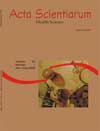Application of the method of PCR-RFLP to the knowledge of HPV types in cervical infections from patients assisted in Lepac, State University of Maringá (UEM)
Abstract
The method of Polymerase Chain Reaction associated with Restriction Fragment Length Polymorphism (PCR-RFLP) was applied in 20 cervical clinical samples from patients with cytologic abnormalities, assisted in LEPAC-UEM. The DNA and the type of HPV were detected and determined in all of the analyzed samples. The great majority of the cervical samples showed HPV types, with high potential for neoplasia development. The method of PCR-RFLP proved great discrimination power, because it was able to detect the DNA and to determine the potential of neoplasia development for up to four different HPV types present in the same cervical sample. The results obtained demonstrated that this method can be used routinely, with high sensibility and reprodutibility, being a choice method in primary screen of patients with risk of developing cervical cancer, contributing with information that help a possible control of this disease.Downloads
Download data is not yet available.
Published
2008-05-06
How to Cite
Kaneshima, E. N., Bidoia, C. C. de G., Gabriel, M., Suzuki, L. E., & Consolaro, M. E. L. (2008). Application of the method of PCR-RFLP to the knowledge of HPV types in cervical infections from patients assisted in Lepac, State University of Maringá (UEM). Acta Scientiarum. Health Sciences, 23, 731-737. https://doi.org/10.4025/actascihealthsci.v23i0.3015
Issue
Section
Health Sciences
DECLARATION OF ORIGINALITY AND COPYRIGHTS
I Declare that current article is original and has not been submitted for publication, in part or in whole, to any other national or international journal.
The copyrights belong exclusively to the authors. Published content is licensed under Creative Commons Attribution 4.0 (CC BY 4.0) guidelines, which allows sharing (copy and distribution of the material in any medium or format) and adaptation (remix, transform, and build upon the material) for any purpose, even commercially, under the terms of attribution.
Read this link for further information on how to use CC BY 4.0 properly.























5.png)







